A photo essay featuring twenty-five of the most impressive communist monuments and memorials in Bulgaria
Of all the countries we’ve visited searching for socialist-era monuments and memorials, Bulgaria is unquestionably the easiest one in which to find them. Even when you take into account that exact coordinates are hard to come by, I’d still argue this to be a true statement.
Looking for otherworldly Tito-era monuments and memorial, known as spomeniks, in the seven countries that once formed Yugoslavia is also a pretty straightforward affair but this is because there is an excellent and definitive source on the subject in the form of the Spomenik Database. For every spomenik listed, Donald Niebyl, the person responsible for the site, provides precise coordinates, driving instructions and even lists the best place to park. It makes searching for spomeniks an enjoyable and, for the best part, fairly stress-free affair (there’s not a lot you can do about the condition of some of the roads in that part of the world!). Yet, with spomeniks, you do still have to ‘find’ them as they are often tucked away in a forest or on the top of a mountain, for example.
There is no such useful resource when it comes to tracking down communist-era monuments in Bulgaria. There is very little information about the subject. We did what research we could before our trip (June 2019), which included bothering our friend Darmon, aka Ex Utopia (formerly the Bohemian Blog). Darmon’s knowledge of communist-era monuments and memorials in Bulgaria is immense. In fact, he is studying towards a PhD in the field and, if we got really stuck on a particular location, we would ask him for assistance. I’m not sure if, in the end, he got bored with our questions (he never showed it if he did!), but he signed off our conversation with the advice that we shouldn’t worry too much about specifics because there are socialist-era monuments wherever you go in Bulgaria.
He was right!
In Bulgaria, monuments and memorials harking back to the country’s communist period (1946-1990) are still numerous and they are kind of ‘just there’. Of the 101 monuments (yep, I kept count!) that we saw on our full-on 10-day road trip around central and coastal Bulgaria, I estimate that just under 50 percent of them we just stumbled upon. And, unlike spomeniks, pametniks (monument in Bulgarian) are much easier to locate. You could be cruising along a back road in the Bulgarian countryside, for instance, and out of the corner of your eye spot a neglected memorial that is only slightly set back and nice and easy to reach. We would also find them in town squares, at the entrance to villages, at T-junctions, in public parks and even once in the middle of a roundabout. In short, they were everywhere!
In fact, we spotted so many unexpected monuments that the only real ‘danger’ we encountered on the Bulgarian roads was either down to me slamming on the breaks because we’d turned a bend and come face to face with yet another monument that was worth photographing, or because I kept making impromptu U-turns as we had overshot something of interest and needed to go back in the direction we’d just come from.

These bonus monuments played havoc with our schedule. We hired the car in the eastern coastal city of Varna and the idea was to drive down the Black Sea coast as far as Burgas and then travel inland through the central part of the country. Bypassing Sofia, we then intended to take a look around the northwest of Bulgaria before coming back through more of the central part as well as a few towns along the Danube River. After a day or so exploring the coastal region north of Varna, we’d drop down to the airport and return the car.
It didn’t quite pan out like that. What we didn’t factor in was how long it would actually take to see so many monuments and memorials. Of course, not all of them were wild cards that we simply stumbled across. Quite a few of the monuments that we had researched prior to setting off, and for which we had precise locations, were miles from anywhere and took time to reach. But, typically, these tended to be the more impressive ones and we didn’t want to miss them. This, combined with unexpectedly doubling the quota of what we actually ended up seeing meant we didn’t get as far as we’d initially planned during the trip. As a result, and for reasons that will become apparent, we ended up skipping the northwest and the Danube in favour of spending the bulk of our time in the central region of Bulgaria.
You might be wondering by this point why were there so many monuments and memorials erected during the country’s socialist period and what do they commemorate?
In Bulgaria, uprising and insurrection equals monuments and memorials.
A reasonable percentage, but by no means all, of the monuments and memorials erected under the instruction of the Bulgaria Communist Party (BCP) after they took power in 1946 are associated with one of three subject matters. The first of these is connected to the 1923 September Uprising, a military rebellion in which the BCP attempted to oust Bulgaria’s existing government and seize control for themselves. The revolt failed but after the communists eventually came to power some twenty-odd years later, they erected numerous memorials to commemorate the event. This was particularly the case in places that played an important part in the uprising, settlements such as Stara Zagora, Maglizh and Shipka, for instance, all of which are located in the central part of the country.
Going further back in time, the second association is the April Uprising of 1876, an organised insurrection against Ottoman rule in Bulgaria that ultimately resulted in the re-establishment of the Bulgarian state two years later (1878). This is an extremely important time in Bulgarian history and the communist regime also marked this event by erecting a vast number of monuments and memorials. Yet again, one of the key regions in which this uprising took place was central Bulgaria.
Away from insurgency, the other thing that the communists in Bulgaria liked commemorating was their country’s strong connection with the Soviet Union and you’ll still find all manner of statues and monuments, often venerating the Soviet Army, in numerous towns and cities across Bulgaria including in, yep you’ve guessed it, the central region of the country.
Not surprisingly, Soviet-related monuments, and to a lesser extent, those associated with the 1923 September Uprising (i.e. communist rule) tend not to be in very good condition. At best, they are neglected and left to the elements but it is not unusual for some of them also to be vandalised. Take the Park-Monument of the Bulgarian-Soviet Friendship in Varna as an example. Our photos were taken a couple of years ago but when we drove past the monument during our recent road trip, we couldn’t fail but notice that the helmet of one of the Soviet soldiers had been spray-painted bright red.
In contrast, many of the memorials we visited that were connected to the April Uprising of 1876, a time in Bulgarian history that had nothing to do with communism, were in excellent condition. Indeed, the same could be said for quite a few of the additional monuments we saw, ones that marked other key events in Bulgarian history and were erected under the communist regime but actually had nothing to do with it (*).
(*) Reminds me of a conversation I had a few years back with the guy at the Tourist Information Centre in Sofia!
Besides monuments associated with the two uprisings mentioned above, and with Russian-Bulgarian friendship, we found a heap of additional monoliths, statues and memorials that were sometimes quite difficult to fathom: a concrete sheep, a tractor on a plinth and a woman carrying bread on her head, to name but a few.
And then there were the concrete titans – the incredible Monument to the Founders of the Bulgarian State in Shumen, the Defenders of Stara Zagora Memorial Complex and of course, iconic Buzludzha. We’d seen all three of these gargantuan structures before but we promised our travel companion, Heather, that we would take her to Shumen and Stara Zagora as she hadn’t seen either and none of us could resist revisiting Buzludzha for a second time. Visiting the latter was very rewarding because we didn’t just focus on the main structure but went off into the forest at its base in search of other smaller monuments and memorials that are completely unknown to most people who make the journey up the mountain.

All things considered, even though our routine at the end of each day for the entire time we were on the road involved zombie-like tiredness and bedtime that wasn’t much past 9pm, the trip was a fantastic success and we saw way more than we anticipated. We aren’t even frustrated that we didn’t complete the journey as planned. Bulgaria is a wonderful country and we now have the perfect excuse to return. Actually, it is already in the diary for 2020. We will fly to Sofia, hire a car and then head northwest to finish off the bits we didn’t manage to do this time around and then travel south to see all the monuments around Plovdiv. Can’t wait!!
Combining over-the-top hulking pieces of concrete, monuments to glory and the downright surreal, below are twenty-five examples of monuments and memorials erected during Bulgaria’s socialist period that we saw during our 2019 road trip:
Arc of Liberty Monument
Situated on the top of the Beklemeto Pass (also known as the Trojan Pass), this was one of the most impressive monuments we saw on the trip. Well maintained, it was completed in 1980 and the design team was headed by Georgi Stoilov, who was also responsible for Buzludzha. The monument is a double commemoration of the Russian Army. In the first instance, it is dedicated to the Trojan (Lovech-Sevlievo) detachment of the Russian Army, which crossed the pass as part of the Russo-Turkish War of 1877-78 and, secondly, it commemorates the Red Army’s arrival in the country in 1944 during World War II.


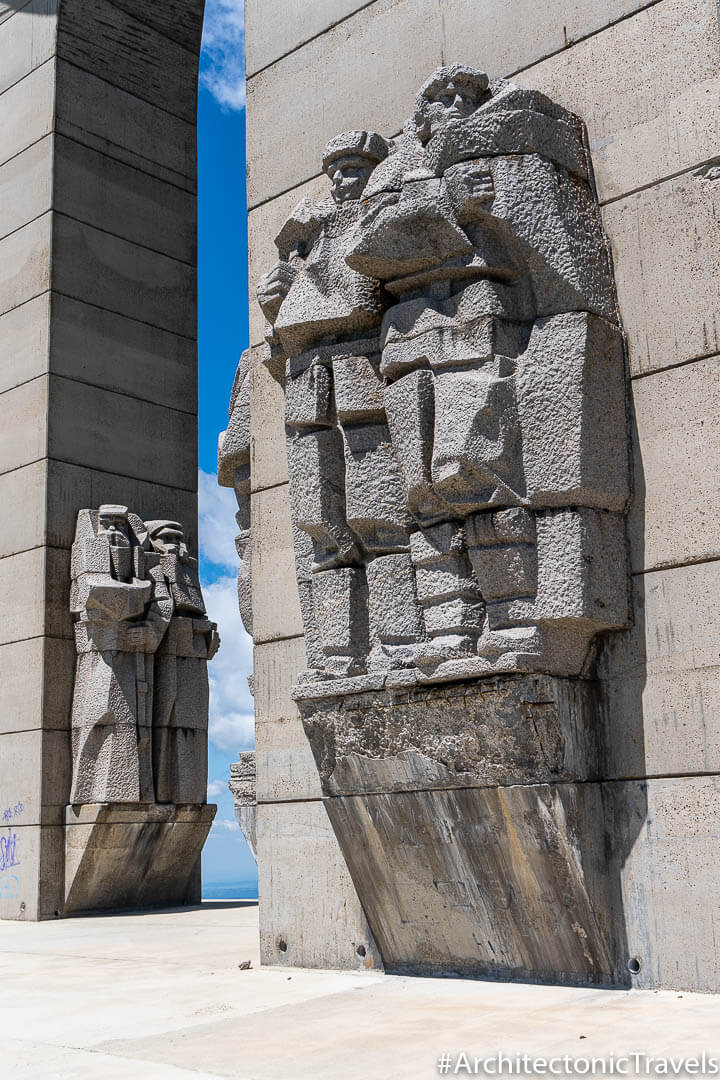
Monument to Yuri Gagarin
Dedicated to the famous Soviet cosmonaut, this monument on the outskirts of Gabrovo had been moved from its original location and we had to enlist the help of the local tourist board to help us find it. They did manage to locate it for us on Google Maps but then proceeded to drive us crazy because neither of them knew how to message us the coordinates. In the end, we had to take over their computer and do it ourselves! The Monument to Yuri Gagarin in Gabrovo was completed in 1971 and the sculptor was Evgeni Kuzmanov.

Memorial Complex Hristo Botev
Hristo Botev is a big deal in Bulgaria. A poet and revolutionary associated with the April Uprising of 1876 (among others), he is considered by many Bulgarians to be a national hero. There are numerous monuments dedicated to his memory throughout the country, but the most impressive is in Kalofer, his town of birth. The complex is in immaculate condition and attracts visitors from all over Bulgaria. Memorial Complex Hristo Botev was completed in 1986 by architects Ivan Nikolov and Luchezar Daskalov, and sculptor Dimitâr Daskalov. The monument depicting the three soldiers, which lists the dates 1923 and 1944 along with 1876, is called the “Three Era” and was added at the insistence of the BCP.

Monument to the Partisans
Located near the village of Balvan and created in 1964, this particular monument was on our original list of places we wanted to see but it took us a while to locate because our coordinates weren’t that accurate. We initially attempted to reach it by hacking our way through some undergrowth but when we realised this wasn’t a sensible idea we drove back the way we had come and tried any alternative route. This was successful and typically, after our initial efforts, it was only slightly set back from the main road and in plain sight. We had plenty of instances like this one!

Monument to the Bulgarian Communist Party
Located in the small town of Krân, which is not far from Buzludzha, the inscription on the monument reads “Here was the club-building of the local BKP (Bulgarian Communist Party) in which in the evening of 19-20 September was created the headquarters of the rebellions in the village of Krân.” The monument was created in 1973 and marks the 50th anniversary of the 1923 September Uprising.

Pantheon of the Fallen in the Fight Against Fascism
Also known as the Fraternal Barrow to the Fallen in the Antifascist Struggle, I think this monument is wonderful. It is located inside Sea Garden, Varna’s oldest and best-known public park and both times we have gone there, it has been in the late afternoon and the light on the monument itself has been perfect. The enormous sculpture on top of the pantheon represents two soldiers in the thick of battle. One of the soldiers is wounded and the other one is protecting him while, at the same time, continuing to fight. The base of the monument is an ossuary, the sides of which are adorned with relief depicting various scenes such as the welcoming of Soviet soldiers, the struggle of the ordinary people against fascism and the euphoria of life under communist rule. The Pantheon in Varna was created in 1959 under the lead guidance of Lyubomir Dalchev and Petâr Kutsarov.

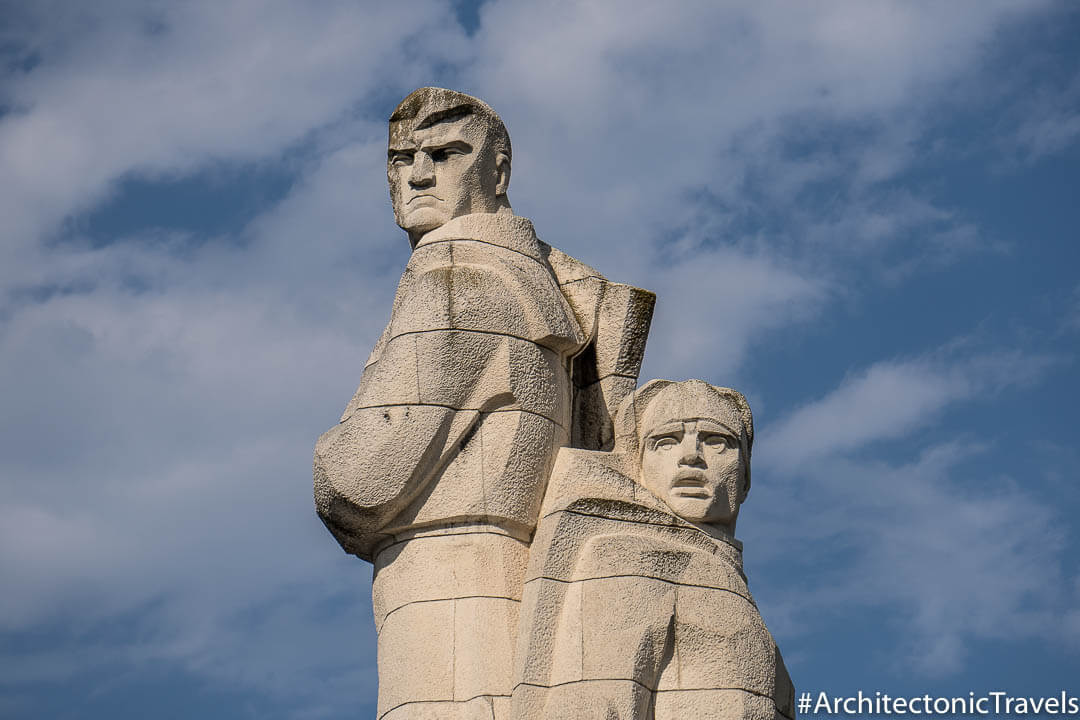
Monument to Prosperity
Near the Black Sea coastal town of Kavarna, we were very keen to see this particular monument but had no idea of its specific whereabouts and so bumping into it en route to somewhere else was a great find.

Monument to Borimechka
Located in the small town of Klisura, this fearsome-looking monument is dedicated to Ivan Tankov, an 1876 Uprising hero who attempted to defend the town with just 200 rebels against a unit of bashi-bazouk numbering more than 2000 men. Defeated by the overpowering Turkish forces, he was captured and shipped to, what is today, Acre in Israel. He acquired the nickname borimechka (wrestler) after capturing two bears. The monument was completed in 1976 by sculptor Metodi Izmirliev.

Mother Bulgaria Monument
Situated in the centre of Pleven, this memorial complex, which is also known as the Monument to the Centenary, was completed in 1978 to commemorate the 100th anniversary of the liberation of Bulgaria from Ottoman rule. The monument represents a female figure celebrating freedom by breaking from chains and raising her arms in defiance.
Looking at archive photos, there used to be a roaring lion positioned on each of the plinths, their heads turned back towards Mother Bulgaria, but they must have been removed at some point because they weren’t there when we visited. Also, note the inclusion of the date “1944” – Bulgaria’s second ‘liberation’ by the Soviets. The architect for this monument was Atanas Atanasov and the sculptor name was Dimitar Boykov.


“The Golden Age”
Representing a symbolic Bulgarian scholar, this interesting cubist-style sculpture was created in 1979 and placed outside Shumen’s regional library in 1981 when the building was completed. The library is named after Shumen-born Stilian Chilingirov (1881-1962) who, himself, was a prominent 20th-century Bulgarian scholar, scientist and politician. He was also one of the founders of the writers’ union of Bulgaria and its president from 1941 to 1944. The monument is the work of sculptor, Valentin Starchev.
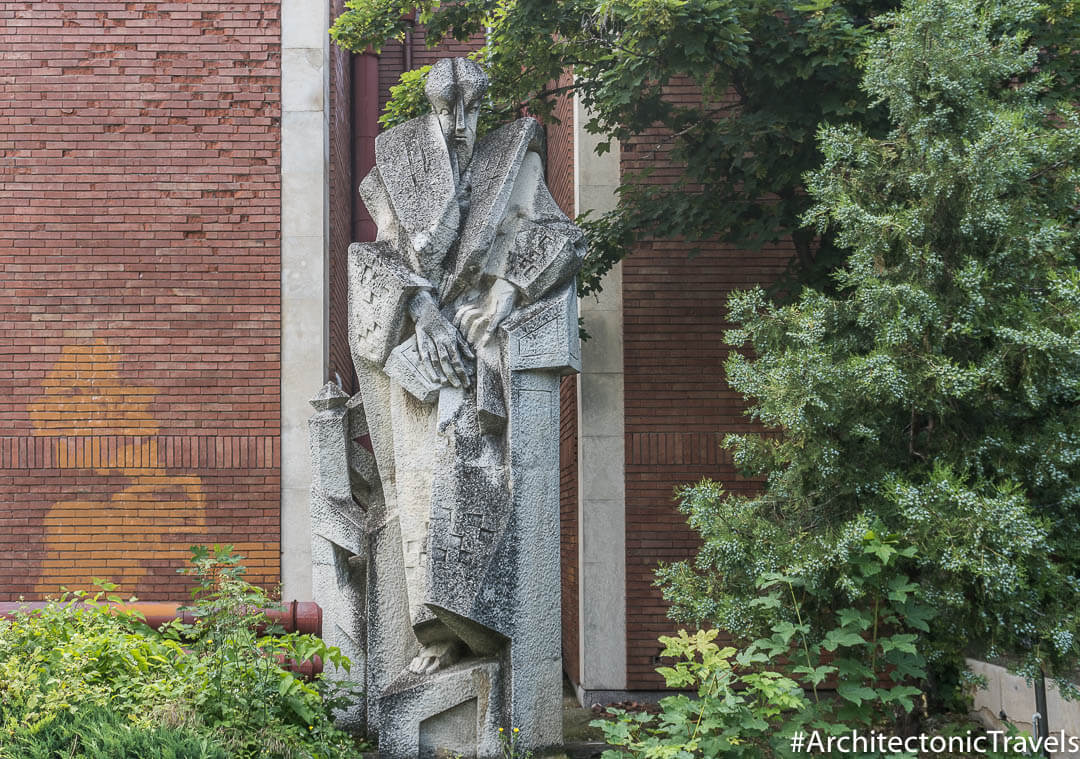
Buzludzha Monument
I guess no self-respecting post about socialist-era monuments in Bulgaria would be complete if it didn’t include the legendary flying-saucer-shaped Buzludzha Monument near Shipka. Completed in 1981 under the instruction of architect, Georgi Stoilov, the structure is looking a bit worse for wear since our first visit three years ago (*) and there is definitely no way of getting inside it anymore as the place is now guarded 24/7 (damn it, why didn’t we try harder first time around!). But, there is no denying it is still an astonishing sight and one of the highlights of this part of Bulgaria. Kirsty has written a more detailed post about our first time to Buzludzha, which you can read here.
(*) The Getty Foundation recently awarded a $185,000 grant for the Buzludzha Monument’s conservation.

Monument to the 1876 Uprising
Not far from Dryanovo Monastery, there were quite a few battles fought in this area during the April Uprising of 1876 and I suspect this is why this particular monument is so grand. It was completed in 1976 by sculptor Ilia Iliev. A bonus monument, we turned a bend and more or less had to do an emergency stop to prevent overshooting this one. Luckily, there was nobody behind us and the fact that I drive at a snail’s pace also went in our favour!
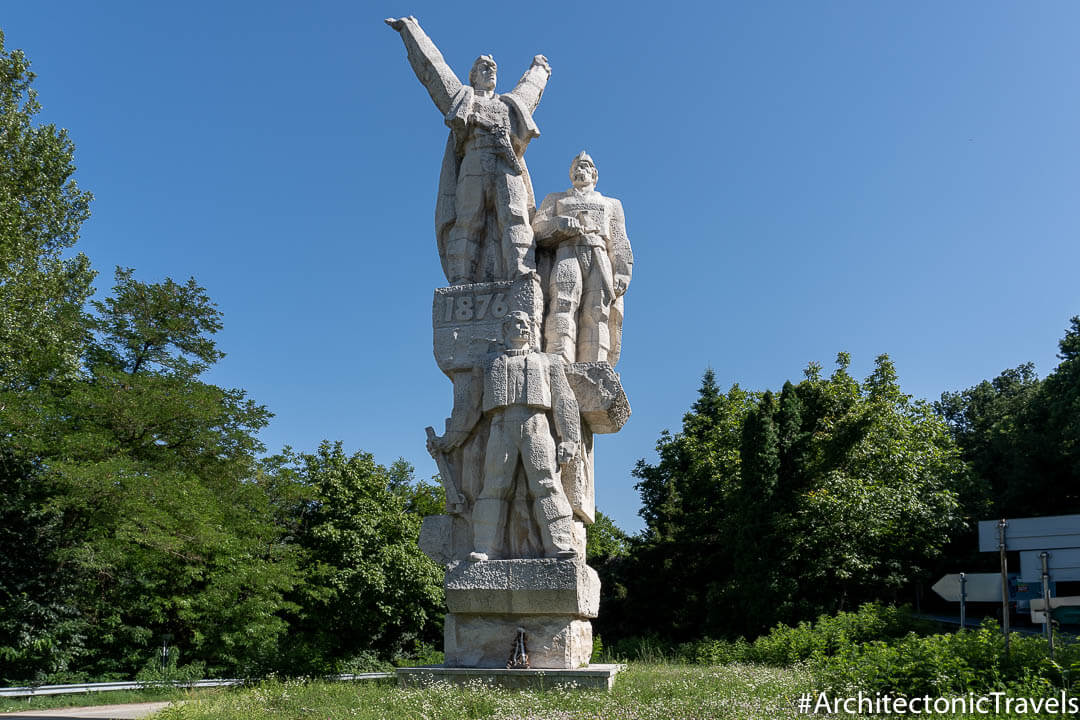
Monument to the September 1923 Uprising
Looking down on Maglizh, this specific monument holds high reverence in communist legend because it was in this unassuming town that insurrectionary activity first started on 14th September 1923 which then inspired other towns and villages to follow suit. The 15-metre statue is made from moulded stainless steel, which was one of the earliest of its kind in the world by all accounts, and is said to portray Georgi ‘Genata’ Dimov, the first person in Maglizh to initiate the uprising. The monument was erected in 1979 and the sculptor was Georgi Varlinkov.

Monument to the Shepherd
The village of Zimnitsa was on our radar for one reason only! For some inexplicable reason, all three of us on the road trip thought this monument was wonderful and we couldn’t stop taking photos of it! It ended up being one of our favourite Communist monuments in Bulgaria.
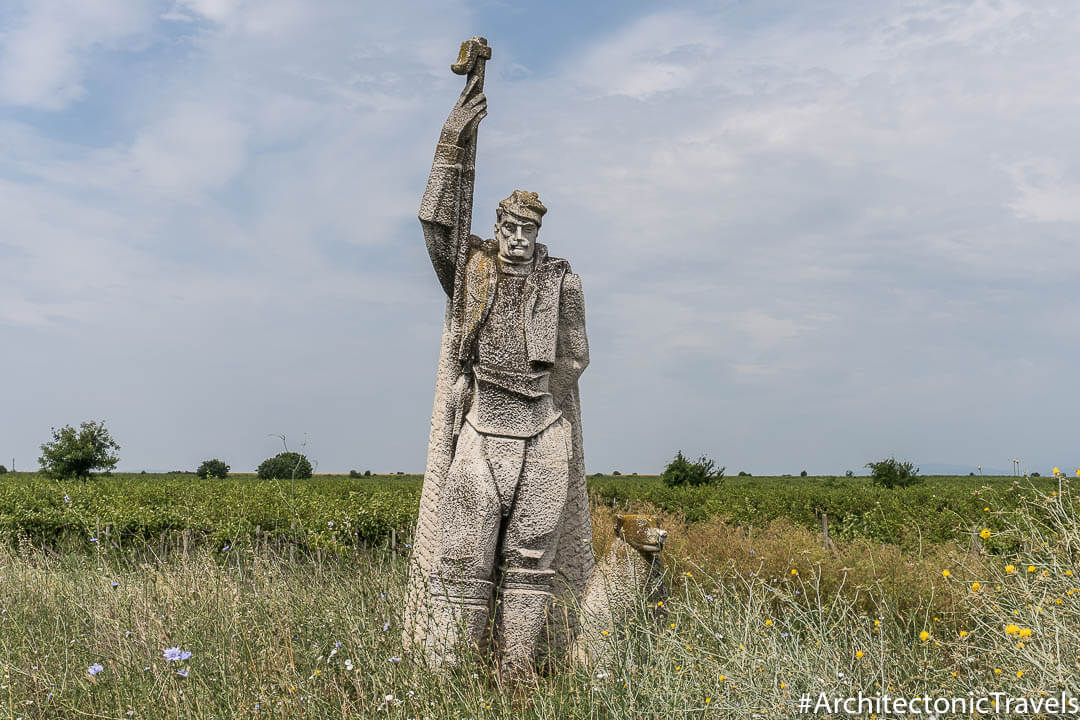
Monument to the 1876 Uprising
Yet another monument to the April Uprising of 1876, this time in Lovech, a city in the north-central part of the country that is probably better known for its covered bridge spanning the Osam River than for this fine-looking sculpture. The monument was completed in 1980 and the artist was Georgi Gergov. As for the bridge, it is one of a few of its kind remaining in Europe that still has shops on it. Don’t let anyone say this blog isn’t helpful and informative!

Ram Monument
We came across this one in a field on the outskirts of Veselinovo. The only question we asked ourselves was “Why?”
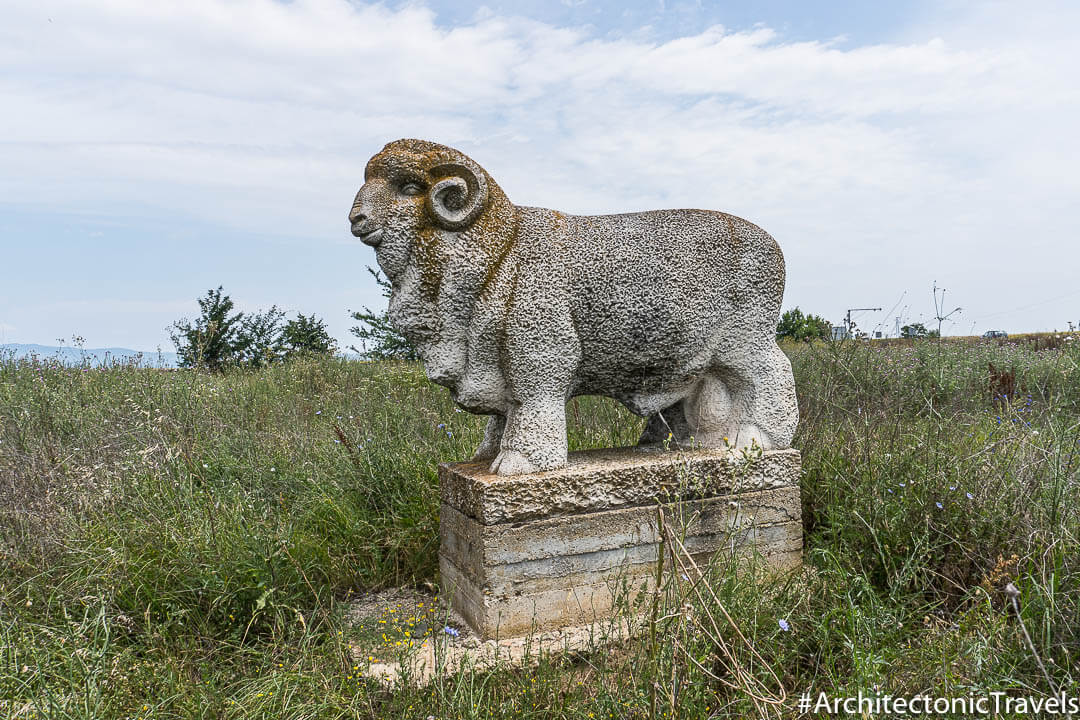
Monument ‘The Defence of Kavarna’
During the Russo-Turkish War of 1877-78, Kavarna’s citizens rose up against the irregular soldiers of the Ottoman Army, known as bashi-bazouk, and liberated the town. Thereafter, it became part of the Principality of Bulgaria, a de facto state that was set up at the end of the war. The Bulgarian inscription on the monument translates to “Kavarna has mainly arisen to protect, it was drowned in blood but arose back from the ashes”. Completed in 1976, the design team for this monument comprised Radi Angelov (sculptor) and I. Bitrakov (architect).


Monument to the Founders of the Bulgarian State
With a dose of The Transformers and a hint of Lord of the Rings, this gargantuan Cubist-style memorial on a hilltop overlooking Shumen is, without question, the most impressive monument we have seen in Bulgaria. It was built in 1981 to commemorate the 1300th anniversary of the founding of the Bulgarian state (681AD). The team of designers consisted of Blagoi Atanasov and Georgi Gechev (architects), Krum Damyanov and Ivan Slavov (sculptors), and Vladislav Paskalev and Stoyan Velev (panel artists).
It’s a beast and if you ever get the chance to see it in the ‘flesh’, I would strongly recommend you do so. You can read more about our first visit to the Monument to the Founders of the Bulgarian State here. All in all, one of the most impressive Communist monuments in Bulgaria.




Monument to Hadzhi Dimitar
Away from the ‘crowds’ of the Buzludzha Monument itself, there are a handful of other memorials and statues in the vicinity that are worth seeing. They include this one dedicated to Hadzhi Dimitar, a revolutionary and military commander who fought tirelessly for the liberation of Bulgaria from Ottoman rule. He died in 1868, in other words, eight years before the 1876 April Uprising, but he was involved in prior insurgent activities and played a prominent role in laying the foundation for the main event. This statue of him was erected in 1961 and the architectural team comprised Lyuben Dimitrov (sculptor) and Zvetan Zvetkov (architect).

The Park-Monument of the Bulgarian-Soviet Friendship
Plenty of controversy surrounds this huge concrete monolith, which is often referred to as the ‘The Russian Monument’, on the outskirts of Varna. Not least, the fact that nobody really knows what to do with it. By all accounts, it is slowly collapsing but it is too close to nearby residential areas to be safely knocked down. It was originally constructed in 1978 under the guidance of Kamen Goranov (architect) and Alyosha Kafedzhiyski and Evgeni Barumov (sculptors). You can read more about our visit to the Park-Monument of the Bulgarian-Soviet Friendship, as well as get a glimpse of what it looks like inside (something that is no longer possible) by clicking here.

Memorial Complex to the Fighters Against Fascism and Capitalism
Also known as the Pantheon of the Immortality and Memorial Fraternal Barrow, this large memorial complex in the northeastern Bulgarian city of Razgrad was completed in 1981. The architects responsible for the work were Ivan Evgeniev and Todorka Daleva. More impressive than the main memorial itself, in my opinion, are the series of large stone bas reliefs that flank either side of the path leading up to it. They were created by sculptor, Georgi Gergov.

Monument to the Fallen Antifascists
Near the village of Tâzha, this monument was typical of the sculptures we would just come across in the Bulgaria countryside. The monument itself was erected in 1974 in honour of partisans from the villages in the central Bulgarian municipality of Pavel Banya who died fighting fascist forces during World War II. The sculptor was Ivan Petrov.

Monument to the first Soviet tractor in Bulgaria
Spotted in Veselinovo, believe it or not, this is not the first tractor monument we have come across in the former communist world. The model is a Russian-built Stalinets S-65, which was manufactured in the Russian city of Chelyabinsk between 1937 and 1941.

Monument “Dobrotitsa”
Dobrotitsa was a Bulgarian noble and ruler of the Principality of Karvuna, a de facto state that split away from medieval Bulgaria in the 14th century. The city in which the monument is located, Dobrich, is named after him and ”Dobrotitsa” was created in 1971 by sculptor, Sekul Krumov. The apartment building in the background sets this monument off very nicely!

Monument to Soviet Cosmonautics
Located in Dryanovo, the monument was erected in honour of Yuri Gagarin’s historic flight into space on April 12, 1961, as well as his subsequent visit to Bulgaria later that year.

DID YOU ENJOY OUR POST FEATURING SOME OF THE MOST INTERESTING COMMUNIST MONUMENTS IN BULGARIA? WHY NOT PIN IT…





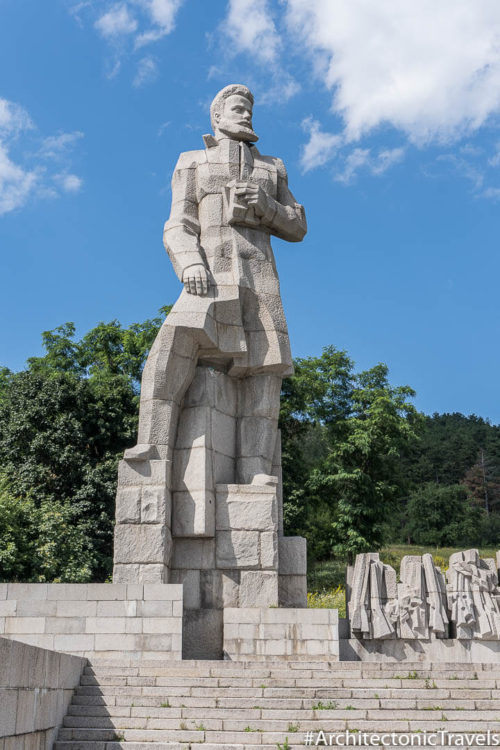



Great article. Thank you for the kind words about my work! I appreciate it.
No problem Donald. I’m sure you are aware that the contents of your website (and book) are a huge inspiration for our road trips throughout the former Yugoslavia. Without the attention to detail that you provide (in particular the coordinates), we wouldn’t see nearly as much as we do and we are very grateful. I think you would enjoy a road trip around Bulgaria as well. If you ever need any assistance with planning one, we would be very happy to help!
Super! It helps for my visit of the monuments!
Excellent. Thank you for letting us know, and enjoy your time in Bulgaria!